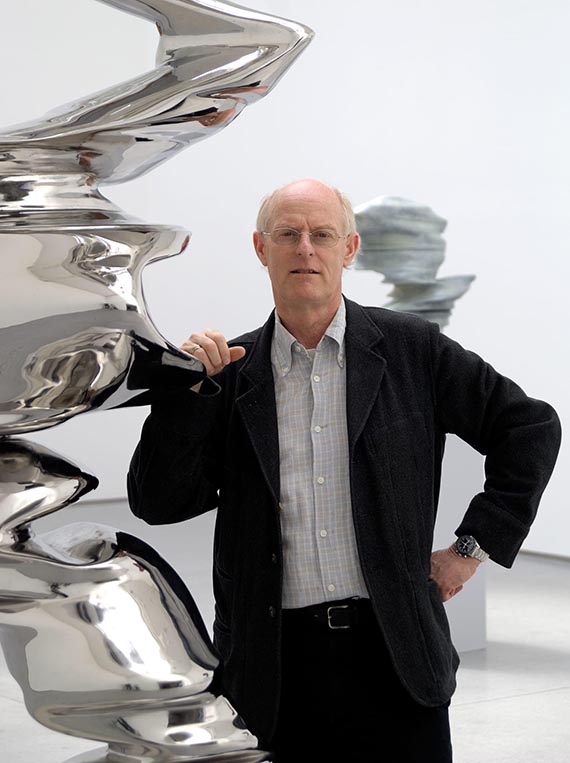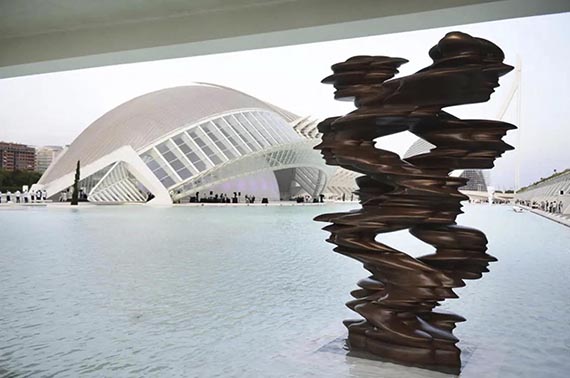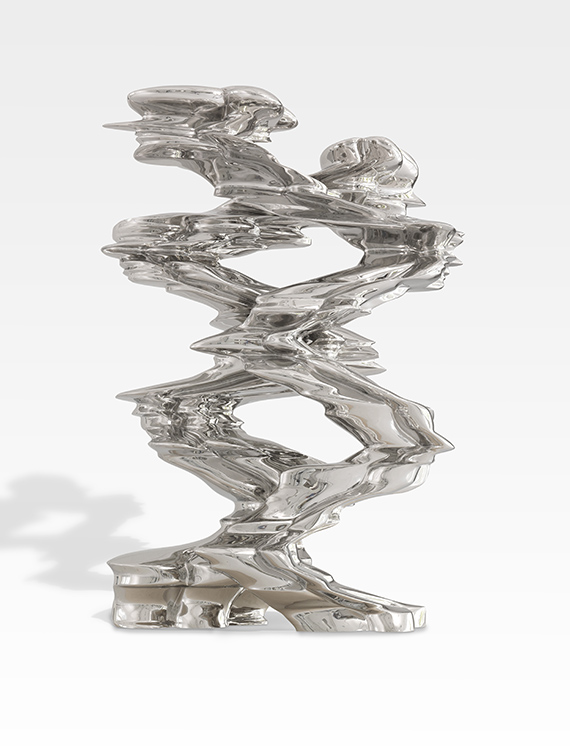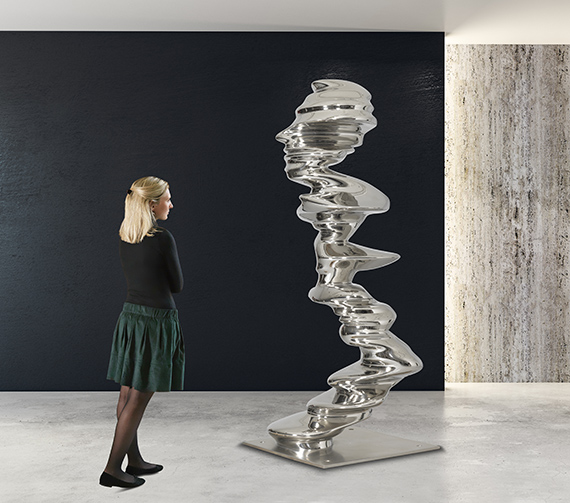Back side
23
Tony Cragg
Runner, 2017.
Stainless steel, polished
Estimate:
€ 300,000 - 400,000
$ 339,000 - 452,000
Runner. 2017.
Stainless steel, polished.
With the artist's signature and the foundry stamp on the side at the bottom. This work is one of a kind due to its size and the manual finish. 175 x 114 x 59 cm (68.8 x 44.8 x 23.2 in).
Cast by the art foundry Schmees, Pirna/Langenfeld.
Until October 26, 2025, the Spanish Tower Sculpture Garden in Darmstadt hosts the exhibition “Tony Cragg.” Along a sculpture trail of about 1.5 km, starting on the plateau of the UNESCO World Heritage Site Mathildenhöhe and ending in the Spanish Tower Sculpture Garden, a variety of monumental works are on display, including a huge stainless steel double sculpture.
• The highly polished stainless steel's allure and elegant form reveal new perspectives from every angle.
• The high-gloss sculpture intriguingly connects artwork, space, and viewer.
• With the “Runner” series, Cragg successfully visualizes energy, movement, and vitality inherent in heavy, static materials.
• Similar works from the “Runner” series can be found, among others, at the Dreischeibenhaus in Düsseldorf, the Istanbul Museum of Modern Art / Istanbul Modern, and the Sculpture Garden of the New Orleans Museum of Art.
• Other stainless steel sculptures are in prominent public spaces worldwide, including One Bangkok, the new district in the heart of Bangkok, and the lobby of the new “One Vanderbilt” super skyscraper on Vanderbilt Avenue in New York.
With a certificate signed and dated by the artist on August 7, 2023.
PROVENANCE: Achenbach Hagemeier Fine Arts , Düsseldorf.
Private collection, North Rhine-Westphalia (acquired from the above).
"The origin of 'Runner' comes from the elliptical columns that become more dynamic. One part is vertical and the other is like a ziggurat, but put together they counterbalance each other, and then you have the feeling that our lives are like this. It reflects a kind of fear, of restlessness. I am an anxious, restless person. It’s my nature. I feel in my head that things come and go, and I like that and I don’t like it, and I want to do this and I don’t want to do it. I have lots of things running around in my head."
Tony Cragg in an interview with Javier Molins, April 23, 2018, quoted from: CAHH / Centro de Arte Hortensia Herrero, https://www.cahh.es/en/artists/tony-cragg/.
Called up: June 6, 2025 - ca. 18.14 h +/- 20 min.
Stainless steel, polished.
With the artist's signature and the foundry stamp on the side at the bottom. This work is one of a kind due to its size and the manual finish. 175 x 114 x 59 cm (68.8 x 44.8 x 23.2 in).
Cast by the art foundry Schmees, Pirna/Langenfeld.
Until October 26, 2025, the Spanish Tower Sculpture Garden in Darmstadt hosts the exhibition “Tony Cragg.” Along a sculpture trail of about 1.5 km, starting on the plateau of the UNESCO World Heritage Site Mathildenhöhe and ending in the Spanish Tower Sculpture Garden, a variety of monumental works are on display, including a huge stainless steel double sculpture.
• The highly polished stainless steel's allure and elegant form reveal new perspectives from every angle.
• The high-gloss sculpture intriguingly connects artwork, space, and viewer.
• With the “Runner” series, Cragg successfully visualizes energy, movement, and vitality inherent in heavy, static materials.
• Similar works from the “Runner” series can be found, among others, at the Dreischeibenhaus in Düsseldorf, the Istanbul Museum of Modern Art / Istanbul Modern, and the Sculpture Garden of the New Orleans Museum of Art.
• Other stainless steel sculptures are in prominent public spaces worldwide, including One Bangkok, the new district in the heart of Bangkok, and the lobby of the new “One Vanderbilt” super skyscraper on Vanderbilt Avenue in New York.
With a certificate signed and dated by the artist on August 7, 2023.
PROVENANCE: Achenbach Hagemeier Fine Arts , Düsseldorf.
Private collection, North Rhine-Westphalia (acquired from the above).
"The origin of 'Runner' comes from the elliptical columns that become more dynamic. One part is vertical and the other is like a ziggurat, but put together they counterbalance each other, and then you have the feeling that our lives are like this. It reflects a kind of fear, of restlessness. I am an anxious, restless person. It’s my nature. I feel in my head that things come and go, and I like that and I don’t like it, and I want to do this and I don’t want to do it. I have lots of things running around in my head."
Tony Cragg in an interview with Javier Molins, April 23, 2018, quoted from: CAHH / Centro de Arte Hortensia Herrero, https://www.cahh.es/en/artists/tony-cragg/.
Called up: June 6, 2025 - ca. 18.14 h +/- 20 min.
The perfect symbiosis of form and material
Viewed from every angle, this sculpture captivates the observer with ever-changing perspectives, constantly revealing new details of Cragg's highly dynamic composition. In the harmony of its irregularity, the artist presents himself as a master of the artistic fusion of form and material, allowing himself to be “taken on a journey” by the diverse materials (cf. Tony Cragg, in: exhibition catalog Parts of the World, Cologne 2016, p. 406). With great dynamic elegance and aesthetic perfection, Cragg shapes the material he uses here, stainless steel that glows like liquid silver, into a form that celebrates its qualities and opens up many different associations for the viewer's imagination. There is no perfect vantage point, as the sculptures reveal a different spectacular interplay of forms from every perspective, making it impossible to determine a front or back. The highly reflective stainless steel works—such as the piece offered here—add another dimension to the artwork by reflecting their surroundings and thus entering into contact with both the space and the viewer, inevitably intertwining them. “I believe that the material world is in a conversation with us all the time.” (Tony Cragg, quoted from: Our Choices Art, Tony Cragg. New Sculptures: https://www.youtube.com/watch?v=bompknGi9Qo&t=10s)

Decades of success
Tony Cragg is undoubtedly one of the internationally most celebrated British sculptors of the 21st century, with a career spanning several decades. He exhibited at documenta 7 and 8 in Kassel in the 1980s, represented the United Kingdom at the Venice Biennale, and received the prestigious Turner Prize. Before his artistic training, which included studies at the Wimbledon School of Art and the Royal College of Art in London, the young Tony Cragg worked briefly as a laboratory assistant in a research lab at the National Rubber Producers Research Association. Even then, his keen interest in natural sciences, chemistry, physics, genetics, and engineering was evident, finding expression in his work from the beginning, both in his ideas and titles and in the forms and materials he used.

Physical presence and dynamic movement
Cragg's works from the “Rational Beings” series, created in the 1990s, are reminiscent of the human spine in the broadest sense. Later sculptures, characterized by an array of curves and bulges, resemble organic structures or microorganisms, while other works, such as the more extreme, rhythmically moving “Dancing Columns” or “Points of View,” play with the laws of geometry, symmetry, and physics. Despite their impressive physical presence, they not only convey a sense of lightness, but as completely static structures, they often evoke a surprising impression of motion: “‘Static’ is an interesting word because it refers to a motionless object. At the same time, however, it informs us that there is no such thing. It suggests a different energy or potential, such as static electricity. The potential energy that is kept in check but still pushes forward.” (Tony Cragg, quoted from: Exhibition catalog Anthony Cragg. Parts of the World, Cologne 2016, p. 403)
The present “Runner” from 2017 also fascinates viewers with its transitory, momentary character: “Runner,” says Cragg, “conveys the feeling you have when you think you know where you're going, but you sense that you might be heading in the wrong direction. This doesn't just apply to minor personal matters, but is often also true of the major trends we sense around us.” (Quoted from: www.salzburgfoundation.at/kunstprojekt-krauthuegel-anthony-cragg-drei-neue-aussenskulpturen/)
Cragg succeeds in creating an apparent movement, a swirling effect, and a suspenseful mutability of the entire object through a wealth of curves, bulges, and bulges combined with the high-gloss surface reflections.
The fascination with the material was most recently explored in the highly acclaimed exhibition “Tony Cragg. Please Touch!” at the Kunstpalast in Düsseldorf in 2024, where visitors were invited to touch Tony Cragg's mesmerizing works. Other recent major exhibitions include those at the Musée du Louvre and the Centre Pompidou in Paris, the Museo Nacional Centro de Arte Reina Sofía in Madrid, the Royal Academy of Arts in London, the Louisiana Museum of Modern Art in Humlebæk, the Belvedere in Vienna, the Kunsthalle Bern, and the Benaki Museum in Athens. [CH]
Viewed from every angle, this sculpture captivates the observer with ever-changing perspectives, constantly revealing new details of Cragg's highly dynamic composition. In the harmony of its irregularity, the artist presents himself as a master of the artistic fusion of form and material, allowing himself to be “taken on a journey” by the diverse materials (cf. Tony Cragg, in: exhibition catalog Parts of the World, Cologne 2016, p. 406). With great dynamic elegance and aesthetic perfection, Cragg shapes the material he uses here, stainless steel that glows like liquid silver, into a form that celebrates its qualities and opens up many different associations for the viewer's imagination. There is no perfect vantage point, as the sculptures reveal a different spectacular interplay of forms from every perspective, making it impossible to determine a front or back. The highly reflective stainless steel works—such as the piece offered here—add another dimension to the artwork by reflecting their surroundings and thus entering into contact with both the space and the viewer, inevitably intertwining them. “I believe that the material world is in a conversation with us all the time.” (Tony Cragg, quoted from: Our Choices Art, Tony Cragg. New Sculptures: https://www.youtube.com/watch?v=bompknGi9Qo&t=10s)

Tony Cragg in front of another stainless steel sculpture. © VG Bild-Kunst, Bonn 2025
Decades of success
Tony Cragg is undoubtedly one of the internationally most celebrated British sculptors of the 21st century, with a career spanning several decades. He exhibited at documenta 7 and 8 in Kassel in the 1980s, represented the United Kingdom at the Venice Biennale, and received the prestigious Turner Prize. Before his artistic training, which included studies at the Wimbledon School of Art and the Royal College of Art in London, the young Tony Cragg worked briefly as a laboratory assistant in a research lab at the National Rubber Producers Research Association. Even then, his keen interest in natural sciences, chemistry, physics, genetics, and engineering was evident, finding expression in his work from the beginning, both in his ideas and titles and in the forms and materials he used.

Another work from the "Runner" series with a different patina, exhibited in the "City of Arts and Sciences" / "Ciutat de les Arts i les Ciències" in Valencia, Spain. © VG Bild-Kunst, Bonn 2025
Physical presence and dynamic movement
Cragg's works from the “Rational Beings” series, created in the 1990s, are reminiscent of the human spine in the broadest sense. Later sculptures, characterized by an array of curves and bulges, resemble organic structures or microorganisms, while other works, such as the more extreme, rhythmically moving “Dancing Columns” or “Points of View,” play with the laws of geometry, symmetry, and physics. Despite their impressive physical presence, they not only convey a sense of lightness, but as completely static structures, they often evoke a surprising impression of motion: “‘Static’ is an interesting word because it refers to a motionless object. At the same time, however, it informs us that there is no such thing. It suggests a different energy or potential, such as static electricity. The potential energy that is kept in check but still pushes forward.” (Tony Cragg, quoted from: Exhibition catalog Anthony Cragg. Parts of the World, Cologne 2016, p. 403)
The present “Runner” from 2017 also fascinates viewers with its transitory, momentary character: “Runner,” says Cragg, “conveys the feeling you have when you think you know where you're going, but you sense that you might be heading in the wrong direction. This doesn't just apply to minor personal matters, but is often also true of the major trends we sense around us.” (Quoted from: www.salzburgfoundation.at/kunstprojekt-krauthuegel-anthony-cragg-drei-neue-aussenskulpturen/)
Cragg succeeds in creating an apparent movement, a swirling effect, and a suspenseful mutability of the entire object through a wealth of curves, bulges, and bulges combined with the high-gloss surface reflections.
The fascination with the material was most recently explored in the highly acclaimed exhibition “Tony Cragg. Please Touch!” at the Kunstpalast in Düsseldorf in 2024, where visitors were invited to touch Tony Cragg's mesmerizing works. Other recent major exhibitions include those at the Musée du Louvre and the Centre Pompidou in Paris, the Museo Nacional Centro de Arte Reina Sofía in Madrid, the Royal Academy of Arts in London, the Louisiana Museum of Modern Art in Humlebæk, the Belvedere in Vienna, the Kunsthalle Bern, and the Benaki Museum in Athens. [CH]
23
Tony Cragg
Runner, 2017.
Stainless steel, polished
Estimate:
€ 300,000 - 400,000
$ 339,000 - 452,000
Buyer's premium, taxation and resale right compensation for Tony Cragg "Runner"
This lot can be purchased subject to differential or regular taxation, artist‘s resale right compensation is due.
Differential taxation:
Hammer price up to 800,000 €: herefrom 32 % premium.
The share of the hammer price exceeding 800,000 € is subject to a premium of 27 % and is added to the premium of the share of the hammer price up to 800,000 €.
The share of the hammer price exceeding 4,000,000 € is subject to a premium of 22 % and is added to the premium of the share of the hammer price up to 4,000,000 €.
The buyer's premium contains VAT, however, it is not shown.
Regular taxation:
Hammer price up to 800,000 €: herefrom 27 % premium.
The share of the hammer price exceeding 800,000 € is subject to a premium of 21% and is added to the premium of the share of the hammer price up to 800,000 €.
The share of the hammer price exceeding 4,000,000 € is subject to a premium of 15% and is added to the premium of the share of the hammer price up to 4,000,000 €.
The statutory VAT of currently 7 % is levied to the sum of hammer price and premium.
We kindly ask you to notify us before invoicing if you wish to be subject to regular taxation.
Calculation of artist‘s resale right compensation:
For works by living artists, or by artists who died less than 70 years ago, a artist‘s resale right compensation is levied in accordance with Section 26 UrhG:
4 % of hammer price from 400.00 euros up to 50,000 euros,
another 3 % of the hammer price from 50,000.01 to 200,000 euros,
another 1 % for the part of the sales proceeds from 200,000.01 to 350,000 euros,
another 0.5 % for the part of the sale proceeds from 350,000.01 to 500,000 euros and
another 0.25 % of the hammer price over 500,000 euros.
The maximum total of the resale right fee is EUR 12,500.
The artist‘s resale right compensation is VAT-exempt.
Differential taxation:
Hammer price up to 800,000 €: herefrom 32 % premium.
The share of the hammer price exceeding 800,000 € is subject to a premium of 27 % and is added to the premium of the share of the hammer price up to 800,000 €.
The share of the hammer price exceeding 4,000,000 € is subject to a premium of 22 % and is added to the premium of the share of the hammer price up to 4,000,000 €.
The buyer's premium contains VAT, however, it is not shown.
Regular taxation:
Hammer price up to 800,000 €: herefrom 27 % premium.
The share of the hammer price exceeding 800,000 € is subject to a premium of 21% and is added to the premium of the share of the hammer price up to 800,000 €.
The share of the hammer price exceeding 4,000,000 € is subject to a premium of 15% and is added to the premium of the share of the hammer price up to 4,000,000 €.
The statutory VAT of currently 7 % is levied to the sum of hammer price and premium.
We kindly ask you to notify us before invoicing if you wish to be subject to regular taxation.
Calculation of artist‘s resale right compensation:
For works by living artists, or by artists who died less than 70 years ago, a artist‘s resale right compensation is levied in accordance with Section 26 UrhG:
4 % of hammer price from 400.00 euros up to 50,000 euros,
another 3 % of the hammer price from 50,000.01 to 200,000 euros,
another 1 % for the part of the sales proceeds from 200,000.01 to 350,000 euros,
another 0.5 % for the part of the sale proceeds from 350,000.01 to 500,000 euros and
another 0.25 % of the hammer price over 500,000 euros.
The maximum total of the resale right fee is EUR 12,500.
The artist‘s resale right compensation is VAT-exempt.
Headquarters
Joseph-Wild-Str. 18
81829 Munich
Phone: +49 89 55 244-0
Fax: +49 89 55 244-177
info@kettererkunst.de
Louisa von Saucken / Christoph Calaminus
Holstenwall 5
20355 Hamburg
Phone: +49 40 37 49 61-0
Fax: +49 40 37 49 61-66
infohamburg@kettererkunst.de
Dr. Simone Wiechers / Nane Schlage
Fasanenstr. 70
10719 Berlin
Phone: +49 30 88 67 53-63
Fax: +49 30 88 67 56-43
infoberlin@kettererkunst.de
Cordula Lichtenberg
Gertrudenstraße 24-28
50667 Cologne
Phone: +49 221 510 908-15
infokoeln@kettererkunst.de
Hessen
Rhineland-Palatinate
Miriam Heß
Phone: +49 62 21 58 80-038
Fax: +49 62 21 58 80-595
infoheidelberg@kettererkunst.de
We will inform you in time.




 Lot 23
Lot 23 



